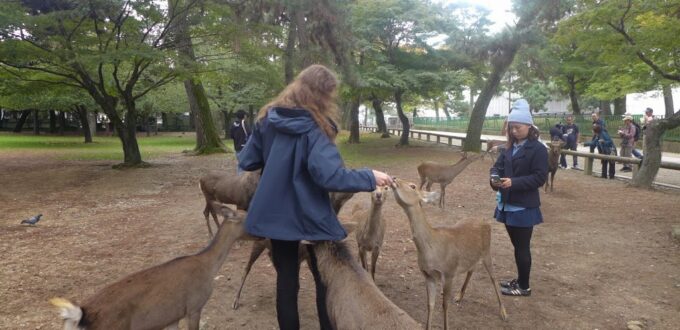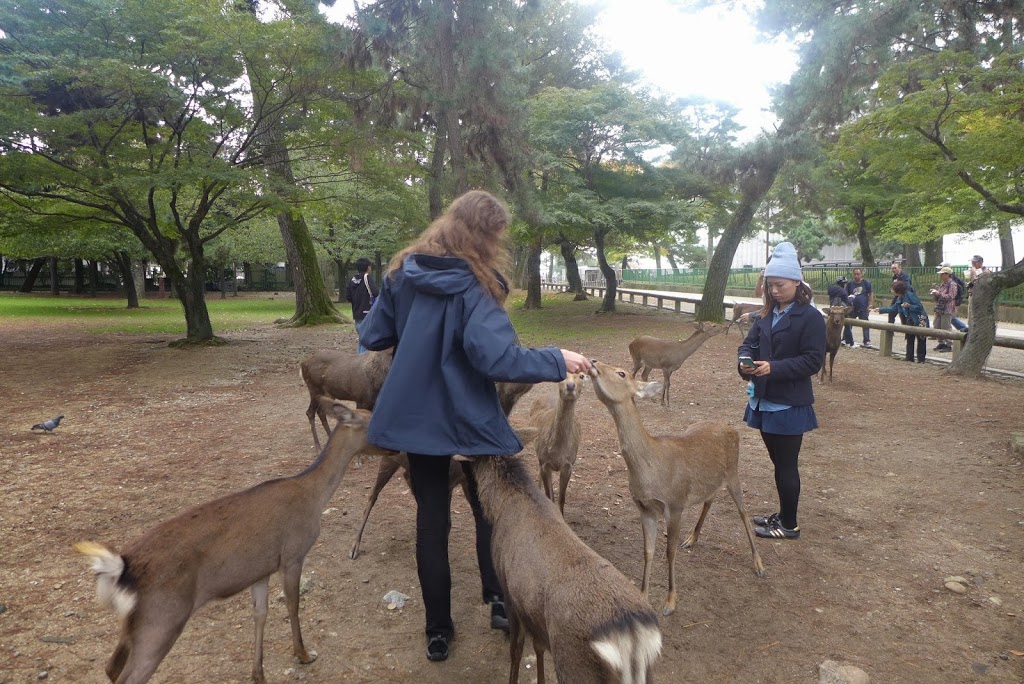Today we decided to see Buddha again. A big one.
We took a train to Nara, another ancient temple town and a former capital (7-9th Century), like Kamakura. Instead of temple complexes lost in mountain valleys, here they were mostly on meadows, which allowed for building much larger structures. But before the temples, the deer. Lots and lots of deer running around the meadows. There is a pretty big forest nearby, but they seem to find way more food here, since for some little money tourists can buy feed for them. And do they want it! Insistent beasts, they were pulling my jacket and head butting me to get more! One really meant business and stole a substantial part of the town map, just biting off bits as I was trying to read it.



First, we went to the Todai-ji temple, which hosts a huge 15m statue of Buddha. It’s a really impressive wooden structure with many huge wooden columns and decorated beams supporting the roof, crossing in most fantastic ways. I spent a while just looking at the structure, checking how it’s built. Pretty amazing. The Buddha himself is too, as were the huge figures of his attendants. After coming out of the building I was blinded by the sun – it’s really warm today, over 20 degrees.


It’s interesting to compare Buddhist and Christian temples. Buddhist temples aren’t really walk-in places. The ceremonies happen mostly on the outside, and are fairly rare – no weekly mass, no congregation, but much more private visits and prayer. This has a clear impact on the architecture: there is no space for the faithful in the temples, which only serve as a sort of altars, or reliquaries. I wonder what influence this had on culture as well. If Christianity, like Buddhism, allowed for the peaceful coexistence of multiple sub-sects, would we still have Marcinians and Manicheans and Bogomils and Cathars and Husites today? How would that impact our world? After all, all the mean things the Church did, resulted in a great deal of progress. The arms race with the infidels, the centralisation of political power and ideology, the accumulation of money, the regular gathering of large congregations sharing a single idea, the preservation of knowledge and establishment of universities with scholars being able to communicate in one language used everywhere on the continent… People always say that a dominant religion like Christianity stifled innovation and promoted backwardness, but perhaps it also gave people motivation, something to rebel against, and allowed for greater concentration of money, ideas, and power. And Shinto and Buddhism, with their decentralised, private character? I don’t know, just seems like they all ended having very different social roles.

We walked around another temple group, complained about the noisy tourists, and went to a couple museums, featuring mainly old Buddhist sculptures. As with buildings, most of them are made of wood – there are few stone ones, all bronze sculptures are tiny, and there no marble statues whatsoever. It generally seems that transience is just a part of culture here – there seems to have been little drive to create things that will last for centuries. I guess part of it is naturally determined: there is little good quality metal in Japan, and there simply is no marble around (they did have plenty other stones though…). Also, if you live in a country where earthquakes happen every other week, seems like little difference whether you build from wood or stone, it will all be rubble sooner or later anyway.

I mentioned noisy people – I must add that they are in minority, and as soon as they walk inside a temple or museum, they are all quiet as a mouse. What a refreshing silence, after all the bloody Westerners who often just can’t shut up and respect the place and others. Similarly, I should have mentioned before how clean it is on here. There is no single tiniest piece of rubbish on the streets! What’s most amazing, is that there are virtually no public rubbish bins either – everyone just takes their mess home. Imagine that in Britain! The Japanese do seem a bit too OCD with the cleanness and sterility – fancy toilets and tidy streets are OK, but you really don’t need to pack every single gum dragette, every single cookie in a pack, in a separate wrapping.
 |
| Looks a bit odd from the outside… |
Back in Osaka, Toshiko invited us to a geisha theatre. I thought that it looked a bit dodgy from the outside, and soon it turned out that it wasn’t a geisha theatre as much as a sort of variety show with people dressing up as geishas. Dancing, fighting, singing, a weird mixture of Western and Japanese tunes… cool! It’s a sort of moving theatre that comes to town for a month, gives a different performance every day, and moves to the next city. Toshiko said most people who were watching were there almost every day.
After that Toshiko took us for sushi! A proper sushi train bar – the plates with different kinds of sushi were passing us and we could just grab more and more. And the flavours! Apart from the usual salmon, tuna, etc., we had caviar, natto (fermented soy beans), smoked salmon with cheese, tempura, pickled mackerel, and… dozens tiny little transparent baby fish. Weird… not sure about the baby fish, but everything else was fantastic!
 |
| We didn’t love the fishes that much |
 |
| A sumo hall |
We were thinking of going to an onsen, a fancy spa/sauna with separate sections for men and women and no need for swimming costumes, but we ran out of money and Eva didn’t feel like going after all. Ah well, next time. I had a very long bath instead.

 We walked around another temple group, complained about the noisy tourists, and went to a couple museums, featuring mainly old Buddhist sculptures. As with buildings, most of them are made of wood – there are few stone ones, all bronze sculptures are tiny, and there no marble statues whatsoever. It generally seems that transience is just a part of culture here – there seems to have been little drive to create things that will last for centuries. I guess part of it is naturally determined: there is little good quality metal in Japan, and there simply is no marble around (they did have plenty other stones though…). Also, if you live in a country where earthquakes happen every other week, seems like little difference whether you build from wood or stone, it will all be rubble sooner or later anyway.
We walked around another temple group, complained about the noisy tourists, and went to a couple museums, featuring mainly old Buddhist sculptures. As with buildings, most of them are made of wood – there are few stone ones, all bronze sculptures are tiny, and there no marble statues whatsoever. It generally seems that transience is just a part of culture here – there seems to have been little drive to create things that will last for centuries. I guess part of it is naturally determined: there is little good quality metal in Japan, and there simply is no marble around (they did have plenty other stones though…). Also, if you live in a country where earthquakes happen every other week, seems like little difference whether you build from wood or stone, it will all be rubble sooner or later anyway.
















yvnovo